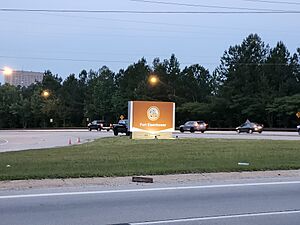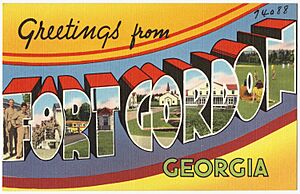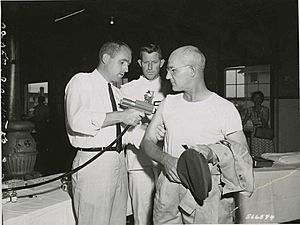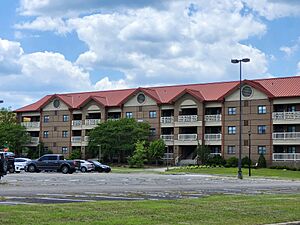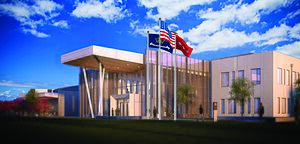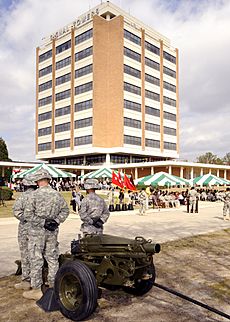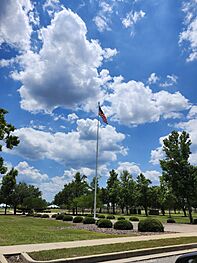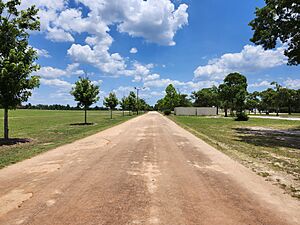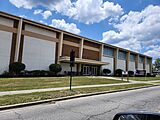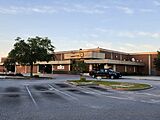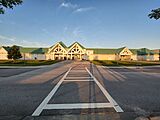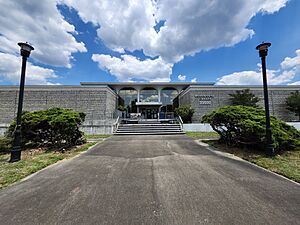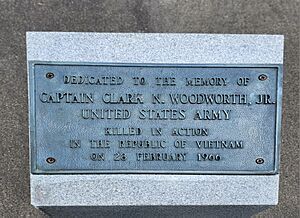Fort Eisenhower facts for kids
Quick facts for kids Fort Eisenhower |
|
|---|---|
| Augusta, Georgia | |
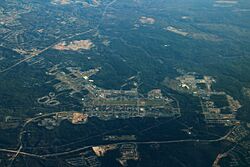
Aerial image of Fort Gordon
|
|
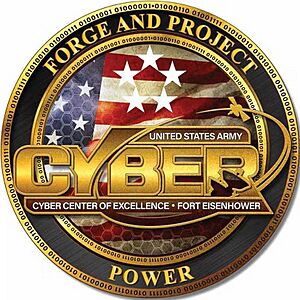 |
|
| Area | 86.87 square miles (225.0 km2) |
| Site information | |
| Owner | United States federal government |
| Controlled by | |
| Status | Active |
| Site history | |
| Built | 1941 |
| In use | October 1941–present |
| Garrison information | |
| Current commander |
Major General Paul T. Stanton |
| Garrison | U.S. Army Garrison Fort Eisenhower |
| Occupants |
|
Fort Eisenhower, once called Fort Gordon, is a large United States Army base. It was started in October 1941 near Augusta, Georgia. Today, it is a key place for the Army's communication and cyber defense teams. It also hosts parts of the National Security Agency, which protects U.S. information. Fort Eisenhower is one of the biggest Army bases worldwide. It has over 16,000 military members and 13,500 civilian workers. A big part of what they do here is train soldiers in communication skills. They also focus on Signals Intelligence, which is about gathering information from electronic signals.
Contents
What's in a Name?
When this base first opened in 1941, it was named Camp Gordon. It honored John Brown Gordon, a general from the Confederate army during the American Civil War. After the war, he became a U.S. Senator and Governor of Georgia. This base was one of several U.S. Army sites named after Confederate officers.
In recent years, the Department of Defense decided to change these names. They wanted to honor different American heroes. So, in 2023, Camp Gordon was renamed Fort Eisenhower. This new name honors Dwight D. Eisenhower. He was a famous general who led the Allied forces in World War II. Later, he became the 34th President of the United States.
It's important to know that a different Camp Gordon existed during World War I. That one was near Atlanta, Georgia. It was closed in 1919. The current Fort Eisenhower near Augusta was built much later, in 1941.
A Look Back: Fort Eisenhower's History
How it Started: World War II
Construction for Camp Gordon began in July 1941. It was planned as a training camp for soldiers during World War II. A special ceremony marked its opening in October. After the attack on Pearl Harbor in December 1941, the camp quickly got ready for action. The 4th Infantry Division was one of the first groups to train there.
During the war, three different Army divisions trained at Camp Gordon. From 1943 to 1945, it also held foreign prisoners of war. After the war ended, from 1945 to 1946, the camp helped nearly 86,000 soldiers leave the Army.
After the War: A Changing Role
After World War II, Camp Gordon was almost closed. But in 1948, the Army moved its Military Police School here. A training center for the Signal Corps also opened. The Signal Corps is the Army branch that handles communications.
In 1956, the base was officially renamed Fort Gordon. For many years, it was a place for basic training. During the Vietnam War, soldiers trained here for special airborne missions.
In 1974, a big change happened. The Army moved its main Signal School from New Jersey to Fort Gordon. This brought all signal training to one place. Since 1986, Fort Gordon has been the home of the Signal Corps Regiment. Their job is to teach soldiers how to set up and maintain communication networks.
Today, Fort Eisenhower is a very diverse base. It trains soldiers in Signal, Military Intelligence, Medical, and especially Cyber skills. The main focus is now on cyber operations.
The Eisenhower Method and Cyber Focus
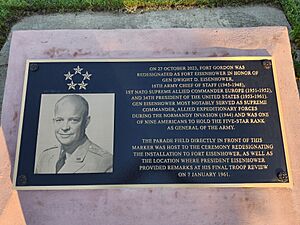
General Dwight D. Eisenhower was known for his smart way of managing tasks. He believed in focusing on important things, even if they weren't urgent. This idea is sometimes called "the Eisenhower box."
Fort Eisenhower has become a 24/7 operational base. This means it's always working to "Operate, Defend, Attack, Influence, and Inform" in the cyber world. This shift happened because the Army's Cyber Command moved here.
Why the Name Change?
In 2022, a special commission suggested renaming the base to Fort Eisenhower. This was to honor General of the Army Dwight D. Eisenhower. He was a hero of World War II and a U.S. President.
The official renaming ceremony took place on October 27, 2023. It was held at Barton Field, where President Eisenhower gave a speech in 1961. His granddaughter, Susan Eisenhower, attended the event. Fort Eisenhower was the last U.S. Army base named after a Confederate figure to be renamed.
Cyber Hub: A New Mission
The Army decided to bring all its cyber operations to one place. In 2013, Fort Gordon was chosen to host the United States Army Cyber Command. This was a huge step for the base.
In 2014, the Army created the US Army Cyber branch and Cyber School at Fort Gordon. Both the Signal School and Cyber School are part of the US Army Cyber Center of Excellence. This center is the main place for cyber education and training.
In 2020, the Army Cyber Command (ARCYBER) moved into its new building, Fortitude Hall. This building is right next to the National Security Agency's Georgia headquarters. Having the Army's cyber operations and its training school in the same place is very helpful. It allows soldiers to learn from real-world cyber experiences.
With these changes, Fort Eisenhower has become a key operational base. It's now a 24/7 center for cyber defense and intelligence.
Training and Daily Operations
The Signal School at Fort Eisenhower teaches soldiers about communication technology. This technology helps the Department of Defense share information safely. One important job they train for is Signal Support Systems Specialist. These soldiers, called 25U, are experts in both signal and cyber tasks. They are in high demand across the Army.
Fort Eisenhower's full name is the U.S. Army Cyber Center of Excellence & Fort Eisenhower. Besides the training schools, many active-duty military units are based here. These include various Signal Brigades, Military Intelligence Brigades, and the Cyber Protection Brigade. The base also hosts parts of the U.S. Air Force, Navy, and Marine Corps.
Fort Eisenhower has about 30,000 military and civilian workers. It brings over $1.1 billion to the local economy each year.
Special Displays
In Freedom Park, you can see two pieces of the famous Berlin Wall. This wall once divided East and West Berlin during the Cold War. It's a powerful reminder of history.
Barton Field
Barton Field is a very large open area in the middle of Fort Eisenhower. It's named after Raymond O. Barton Sr., a World War II general from Augusta. He was a key commander during D-Day in 1944.
Barton Field is used for many things. Soldiers do their morning physical training there. It's also a place for festivals and other events. A running track almost three miles long goes all around Barton Field.
Fun Things to Do on Base
Fort Eisenhower has many cool places for soldiers and their families. Some are even open to the public!
- Eisenhower Lakes Golf Club: A full golf course.
- Five Star Lanes: A 24-lane bowling alley with food and a game area.
- Outdoor Pool and Water Park: Great for hot days.
- Escape Room: A fun challenge for groups.
- Hilltop Riding Stables: For horse lovers.
- Gyms and Fitness Centers: To stay active.
- Disc Golf Course and Shooting Range: For outdoor fun.
- Restaurants: Many places to eat.
The main shopping area is the Post Exchange (PX) and the Commissary. The PX is like a department store with shops like GameStop and a food court with Starbucks, Popeyes, and Subway. The Commissary is a full grocery store. There are also smaller "shoppettes" for quick stops.
Woodworth Library
Woodworth Library is the main library on base. It's open to military members and their families. The library is named after Captain Clark Newell Woodworth Jr. He was an Army captain who died in Vietnam in 1966. His name is on the Vietnam Veterans Memorial in Washington, D.C. The library has about 40,000 books and a computer lab for everyone to use. It's located right across the street from Barton Field.


